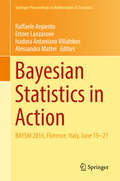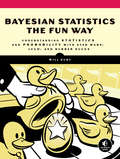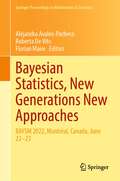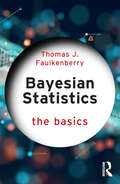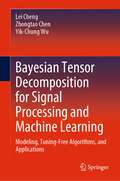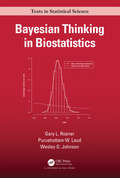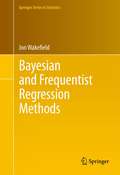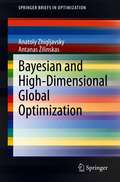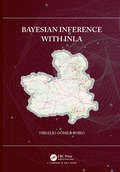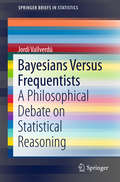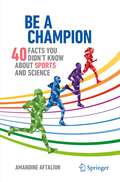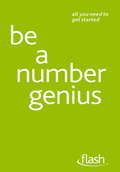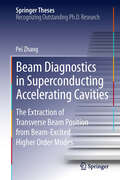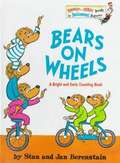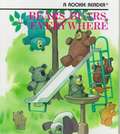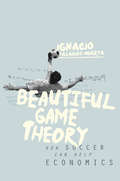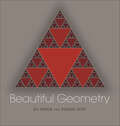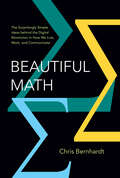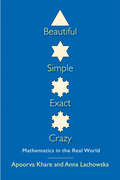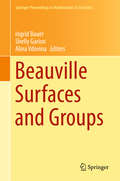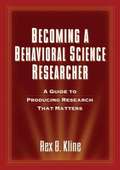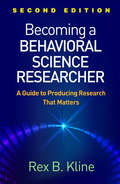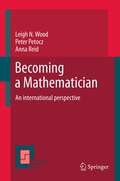- Table View
- List View
Bayesian Statistics in Action: BAYSM 2016, Florence, Italy, June 19-21 (Springer Proceedings in Mathematics & Statistics #194)
by Ettore Lanzarone Raffaele Argiento Isadora Antoniano Villalobos Alessandra MatteiThis book is a selection of peer-reviewed contributions presented at the third Bayesian Young Statisticians Meeting, BAYSM 2016, Florence, Italy, June 19-21. The meeting provided a unique opportunity for young researchers, M. S. students, Ph. D. students, and postdocs dealing with Bayesian statistics to connect with the Bayesian community at large, to exchange ideas, and to network with others working in the same field. The contributions develop and apply Bayesian methods in a variety of fields, ranging from the traditional (e. g. , biostatistics and reliability) to the most innovative ones (e. g. , big data and networks).
Bayesian Statistics the Fun Way: Understanding Statistics and Probability with Star Wars, LEGO, and Rubber Ducks
by Will KurtFun guide to learning Bayesian statistics and probability through unusual and illustrative examples.Probability and statistics are increasingly important in a huge range of professions. But many people use data in ways they don't even understand, meaning they aren't getting the most from it. Bayesian Statistics the Fun Way will change that.This book will give you a complete understanding of Bayesian statistics through simple explanations and un-boring examples. Find out the probability of UFOs landing in your garden, how likely Han Solo is to survive a flight through an asteroid shower, how to win an argument about conspiracy theories, and whether a burglary really was a burglary, to name a few examples.By using these off-the-beaten-track examples, the author actually makes learning statistics fun. And you'll learn real skills, like how to:- How to measure your own level of uncertainty in a conclusion or belief- Calculate Bayes theorem and understand what it's useful for- Find the posterior, likelihood, and prior to check the accuracy of your conclusions- Calculate distributions to see the range of your data- Compare hypotheses and draw reliable conclusions from themNext time you find yourself with a sheaf of survey results and no idea what to do with them, turn to Bayesian Statistics the Fun Way to get the most value from your data.
Bayesian Statistics, New Generations New Approaches: BAYSM 2022, Montréal, Canada, June 22–23 (Springer Proceedings in Mathematics & Statistics #435)
by Alejandra Avalos-Pacheco Roberta De Vito Florian MaireThis book hosts the results presented at the 6th Bayesian Young Statisticians Meeting 2022 in Montréal, Canada, held on June 22–23, titled "Bayesian Statistics, New Generations New Approaches". This collection features selected peer-reviewed contributions that showcase the vibrant and diverse research presented at meeting. This book is intended for a broad audience interested in statistics and aims at providing stimulating contributions to theoretical, methodological, and computational aspects of Bayesian statistics. The contributions highlight various topics in Bayesian statistics, presenting promising methodological approaches to address critical challenges across diverse applications. This compilation stands as a testament to the talent and potential within the j-ISBA community. This book is meant to serve as a catalyst for continued advancements in Bayesian methodology and its applications and encourages fruitful collaborations that push the boundaries of statistical research.
Bayesian Statistics: The Basics (The Basics)
by Thomas J. FaulkenberryBayesian Statistics: The Basics provides a comprehensive yet accessible introduction to Bayesian statistics, specifically tailored for any researcher with an interest in statistical methods. It covers the theoretical foundations of Bayesian inference, contrasting it with classical statistical methods like null hypothesis significance testing. The book emphasizes key concepts such as prior and posterior distributions, Bayes’ theorem, and the Bayes factor, making them understandable even for readers with minimal mathematical backgrounds.Methodologically, the book offers practical, step-by-step guides on how to conduct Bayesian analyses using the free software package JASP. Each chapter focuses on applying Bayesian methods to common research designs with real-world data. Readers will benefit from the clear examples, visualizations, and JASP screenshots that ensure the learning experience is interactive and easy to follow.Full of practical content, the book emphasizes the advantages of Bayesian model comparison over traditional approaches, especially in quantifying evidence for competing hypotheses. Readers will also learn how to perform sensitivity analyses to assess the impact of different prior assumptions on their results.By the end of the book, readers will get both the theoretical understanding and practical skills to implement Bayesian methods in their own research, making it an invaluable resource for both novice and experienced researchers studying Bayesian statistics.
Bayesian Tensor Decomposition for Signal Processing and Machine Learning: Modeling, Tuning-Free Algorithms, and Applications
by Lei Cheng Zhongtao Chen Yik-Chung WuThis book presents recent advances of Bayesian inference in structured tensor decompositions. It explains how Bayesian modeling and inference lead to tuning-free tensor decomposition algorithms, which achieve state-of-the-art performances in many applications, includingblind source separation;social network mining;image and video processing;array signal processing; and,wireless communications.The book begins with an introduction to the general topics of tensors and Bayesian theories. It then discusses probabilistic models of various structured tensor decompositions and their inference algorithms, with applications tailored for each tensor decomposition presented in the corresponding chapters. The book concludes by looking to the future, and areas where this research can be further developed.Bayesian Tensor Decomposition for Signal Processing and Machine Learning is suitable for postgraduates and researchers with interests in tensor data analytics and Bayesian methods.
Bayesian Thinking in Biostatistics (Chapman & Hall/CRC Texts in Statistical Science)
by Wesley O. Johnson Gary L Rosner Purushottam W. LaudPraise for Bayesian Thinking in Biostatistics: "This thoroughly modern Bayesian book …is a 'must have' as a textbook or a reference volume. Rosner, Laud and Johnson make the case for Bayesian approaches by melding clear exposition on methodology with serious attention to a broad array of illuminating applications. These are activated by excellent coverage of computing methods and provision of code. Their content on model assessment, robustness, data-analytic approaches and predictive assessments…are essential to valid practice. The numerous exercises and professional advice make the book ideal as a text for an intermediate-level course…" -Thomas Louis, Johns Hopkins University "The book introduces all the important topics that one would usually cover in a beginning graduate level class on Bayesian biostatistics. The careful introduction of the Bayesian viewpoint and the mechanics of implementing Bayesian inference in the early chapters makes it a complete self- contained introduction to Bayesian inference for biomedical problems….Another great feature for using this book as a textbook is the inclusion of extensive problem sets, going well beyond construed and simple problems. Many exercises consider real data and studies, providing very useful examples in addition to serving as problems." - Peter Mueller, University of Texas With a focus on incorporating sensible prior distributions and discussions on many recent developments in Bayesian methodologies, Bayesian Thinking in Biostatistics considers statistical issues in biomedical research. The book emphasizes greater collaboration between biostatisticians and biomedical researchers. The text includes an overview of Bayesian statistics, a discussion of many of the methods biostatisticians frequently use, such as rates and proportions, regression models, clinical trial design, and methods for evaluating diagnostic tests. Key Features Applies a Bayesian perspective to applications in biomedical science Highlights advances in clinical trial design Goes beyond standard statistical models in the book by introducing Bayesian nonparametric methods and illustrating their uses in data analysis Emphasizes estimation of biomedically relevant quantities and assessment of the uncertainty in this estimation Provides programs in the BUGS language, with variants for JAGS and Stan, that one can use or adapt for one's own research The intended audience includes graduate students in biostatistics, epidemiology, and biomedical researchers, in general Authors Gary L. Rosner is the Eli Kennerly Marshall, Jr., Professor of Oncology at the Johns Hopkins School of Medicine and Professor of Biostatistics at the Johns Hopkins Bloomberg School of Public Health. Purushottam (Prakash) W. Laud is Professor in the Division of Biostatistics, and Director of the Biostatistics Shared Resource for the Cancer Center, at the Medical College of Wisconsin. Wesley O. Johnson is professor Emeritus in the Department of Statistics as the University of California, Irvine.
Bayesian and Frequentist Regression Methods (Springer Series in Statistics)
by Jon WakefieldThis book provides a balanced, modern summary of Bayesian and frequentist methods for regression analysis.
Bayesian and High-Dimensional Global Optimization (SpringerBriefs in Optimization)
by Anatoly Zhigljavsky Antanas ŽilinskasAccessible to a variety of readers, this book is of interest to specialists, graduate students and researchers in mathematics, optimization, computer science, operations research, management science, engineering and other applied areas interested in solving optimization problems. Basic principles, potential and boundaries of applicability of stochastic global optimization techniques are examined in this book. A variety of issues that face specialists in global optimization are explored, such as multidimensional spaces which are frequently ignored by researchers. The importance of precise interpretation of the mathematical results in assessments of optimization methods is demonstrated through examples of convergence in probability of random search. Methodological issues concerning construction and applicability of stochastic global optimization methods are discussed, including the one-step optimal average improvement method based on a statistical model of the objective function. A significant portion of this book is devoted to an analysis of high-dimensional global optimization problems and the so-called ‘curse of dimensionality’. An examination of the three different classes of high-dimensional optimization problems, the geometry of high-dimensional balls and cubes, very slow convergence of global random search algorithms in large-dimensional problems , and poor uniformity of the uniformly distributed sequences of points are included in this book.
Bayesian inference with INLA
by Virgilio Gomez-RubioThe integrated nested Laplace approximation (INLA) is a recent computational method that can fit Bayesian models in a fraction of the time required by typical Markov chain Monte Carlo (MCMC) methods. INLA focuses on marginal inference on the model parameters of latent Gaussian Markov random fields models and exploits conditional independence properties in the model for computational speed. Bayesian Inference with INLA provides a description of INLA and its associated R package for model fitting. This book describes the underlying methodology as well as how to fit a wide range of models with R. Topics covered include generalized linear mixed-effects models, multilevel models, spatial and spatio-temporal models, smoothing methods, survival analysis, imputation of missing values, and mixture models. Advanced features of the INLA package and how to extend the number of priors and latent models available in the package are discussed. All examples in the book are fully reproducible and datasets and R code are available from the book website. This book will be helpful to researchers from different areas with some background in Bayesian inference that want to apply the INLA method in their work. The examples cover topics on biostatistics, econometrics, education, environmental science, epidemiology, public health, and the social sciences.
Bayesians Versus Frequentists: A Philosophical Debate on Statistical Reasoning (SpringerBriefs in Statistics #0)
by Jordi VallverdúThis book analyzes the origins of statistical thinking as well as its related philosophical questions, such as causality, determinism or chance. Bayesian and frequentist approaches are subjected to a historical, cognitive and epistemological analysis, making it possible to not only compare the two competing theories, but to also find a potential solution. The work pursues a naturalistic approach, proceeding from the existence of numerosity in natural environments to the existence of contemporary formulas and methodologies to heuristic pragmatism, a concept introduced in the book's final section. This monograph will be of interest to philosophers and historians of science and students in related fields. Despite the mathematical nature of the topic, no statistical background is required, making the book a valuable read for anyone interested in the history of statistics and human cognition.
Be a Champion: 40 Facts You Didn't Know About Sports and Science (Copernicus Books)
by Amandine AftalionWhy do you lean in a bend? Why does a sprinter slow down before the finish line? Why do golf balls have dimples? Why do you swim better slightly underwater? Why, on a bike, the faster you go, the more stable you are? Why shouldn’t you rely on doping tests too much? Is there a law of evolution of records?These are some of the 40 questions that Amandine Aftalion answers in this book using simple physics and mathematics, and some humor. Not only will it allow you to improve yourself in sports, but it will also but it will also give way to understanding how champions do.An easy book to read and the must to have if you are a sports addict or if you watch sports on TV and ask yourself “why?”.Amandine Aftalion is a French mathematician. She is a CNRS senior scientist and graduated from École normale supérieure in Paris. She has given talks all over the world, as a specialist of models coming from low temperature physics. She has written a book on vortices in Bose–Einstein condensates. More recently, she has used energy minimization to study an optimal control problem coming from human energy: optimizing running. She has written papers on sports aimed at coaches. Part of her latest results have inspired the first chapter of this book. She is the producer and director of a French YouTube channel for the popularization of mathematics, Videodimath, elected as one of the 5 best French YouTube channels for popular mathematics.
Be a Number Genius: Flash
by Jonathan Hancock Jon ChapmanThe books in this bite-sized new series contain no complicated techniques or tricky materials, making them ideal for the busy, the time-pressured or the merely curious. Be A Number Genius is a fun and completely absorbing guide to the magic of numbers, and how to harness their power to improve your professional progress, make better decisions, and solve everyday problems. In just 96 pages you will discover a complete toolkit for how to sharpen your mind and become 100% more mentally acute.
Be a Number Genius: Flash
by Jonathan Hancock Jon ChapmanThe books in this bite-sized new series contain no complicated techniques or tricky materials, making them ideal for the busy, the time-pressured or the merely curious. Be A Number Genius is a fun and completely absorbing guide to the magic of numbers, and how to harness their power to improve your professional progress, make better decisions, and solve everyday problems. In just 96 pages you will discover a complete toolkit for how to sharpen your mind and become 100% more mentally acute.
Beam Diagnostics in Superconducting Accelerating Cavities: The Extraction of Transverse Beam Position from Beam-Excited Higher Order Modes (Springer Theses)
by Pei ZhangAn energetic charged particle beam introduced to an rf cavity excites a wakefield therein. This wakefield can be decomposed into a series of higher order modes and multipoles, which for sufficiently small beam offsets are dominated by the dipole component. This work focuses on using these dipole modes to detect the beam position in third harmonic superconducting S-band cavities for light source applications. A rigorous examination of several means of analysing the beam position based on signals radiated to higher order modes ports is presented. Experimental results indicate a position resolution, based on this technique, of 20 microns over a complete module of 4 cavities. Methods are also indicated for improving the resolution and for applying this method to other cavity configurations. This work is distinguished by its clarity and potential for application to several other international facilities. The material is presented in a didactic style and is recommended both for students new to the field, and for scientists well-versed in the field of rf diagnostics.
Bears on Wheels
by Stan Berenstain Jan BerenstainAn acrobatic act begins with one bear on a unicycle and ends with twenty-one bears and sixteen wheels flying through the air.
Bears, Bears, Everywhere
by Rita MiliosAn observer of one bear in the air, two bears on the stairs, counts all the way up to ten bears huffing and puffing and is relieved that they're full of stuffing.
Beautiful Game Theory: How Soccer Can Help Economics
by Ignacio Palacios-HuertaThe first book to use the world's most popular sport to test economic theories and document novel human behaviorA wealth of research in recent decades has seen the economic approach to human behavior extended over many areas previously considered to belong to sociology, political science, law, and other fields. Research has also shown that economics can provide insight into many aspects of sports, including soccer. Beautiful Game Theory is the first book that uses soccer to test economic theories and document novel human behavior.In this brilliant and entertaining book, Ignacio Palacios-Huerta illuminates economics through the world's most popular sport. He offers unique and often startling insights into game theory and microeconomics, covering topics such as mixed strategies, discrimination, incentives, and human preferences. He also looks at finance, experimental economics, behavioral economics, and neuroeconomics. Soccer provides rich data sets and environments that shed light on universal economic principles in interesting and useful ways.Essential reading for students, researchers, and sports enthusiasts, Beautiful Game Theory is the first book to show what soccer can do for economics.
Beautiful Geometry
by Eli Maor Eugen JostAn exquisite visual celebration of the 2,500-year history of geometryIf you've ever thought that mathematics and art don't mix, this stunning visual history of geometry will change your mind. As much a work of art as a book about mathematics, Beautiful Geometry presents more than sixty exquisite color plates illustrating a wide range of geometric patterns and theorems, accompanied by brief accounts of the fascinating history and people behind each. With artwork by Swiss artist Eugen Jost and text by math historian Eli Maor, this unique celebration of geometry covers numerous subjects, from straightedge-and-compass constructions to intriguing configurations involving infinity. The result is a delightful and informative illustrated tour through the 2,500-year-old history of one of the most important branches of mathematics.
Beautiful Math: The Surprisingly Simple Ideas behind the Digital Revolution in How We Live, Work, and Communicate
by Chris BernhardtFrom the bestselling author of Quantum Computing for Everyone, a concise, accessible, and elegant approach to mathematics that not only illustrates concepts but also conveys the surprising nature of the digital information age.Most of us know something about the grand theories of physics that transformed our views of the universe at the start of the twentieth century: quantum mechanics and general relativity. But we are much less familiar with the brilliant theories that make up the backbone of the digital revolution. In Beautiful Math, Chris Bernhardt explores the mathematics at the very heart of the information age. He asks questions such as: What is information? What advantages does digital information have over analog? How do we convert analog signals into digital ones? What is an algorithm? What is a universal computer? And how can a machine learn?The four major themes of Beautiful Math are information, communication, computation, and learning. Bernhardt typically starts with a simple mathematical model of an important concept, then reveals a deep underlying structure connecting concepts from what, at first, appear to be unrelated areas. His goal is to present the concepts using the least amount of mathematics, but nothing is oversimplified. Along the way, Bernhardt also discusses alphabets, the telegraph, and the analog revolution; information theory; redundancy and compression; errors and noise; encryption; how analog information is converted into digital information; algorithms; and, finally, neural networks. Historical anecdotes are included to give a sense of the technology at that time, its impact, and the problems that needed to be solved.Taking its readers by the hand, regardless of their math background, Beautiful Math is a fascinating journey through the mathematical ideas that undergird our everyday digital interactions.
Beautiful, Simple, Exact, Crazy: Mathematics in the Real World
by Apoorva Khare Anne LachowskaTwo mathematicians explore how math fits into everything from art, music, and literature to space probes and game shows.In this vibrant work, which is ideal for both teaching and learning, Apoorva Khare and Anna Lachowska explain the mathematics essential for understanding and appreciating our quantitative world. They show with examples that mathematics is a key tool in the creation and appreciation of art, music, and literature, not just science and technology. The book covers basic mathematical topics from logarithms to statistics, but the authors eschew mundane finance and probability problems. Instead, they explain how modular arithmetic helps keep our online transactions safe, how logarithms justify the twelve-tone scale commonly used in music, and how transmissions by deep space probes are like knights serving as messengers for their traveling prince.Perfect for coursework in introductory mathematics and requiring no knowledge of calculus, Khare and Lachowska&’s enlightening mathematics tour will appeal to a wide audience.&“A whirlwind tour through mathematics and its applications to the real world, laced with stimulating exercises and fascinating historical insights. Destined to become a classic of mathematical exposition.&” —Eli Maor, author of e: the Story of a Number and Trigonometric Delights&“Khare and Lachowska introduce bite-size pieces of important math by surrounding them with interesting context, from the Monty Hall problem for probability to a story by Dino Buzzati for velocity. Math treated with seriousness and fun.&” —Michael Frame, co-author, with Benoit Mandelbrot, of Fractals, Graphics, and Mathematics Education&“An excellent book, well-suited for a thoughtful, quantitatively-rigorous &‘Math for Humanists&’ course.&” —William Goldbloom Bloch, author of The Unimaginable Mathematics of Borges&’ Library of Babel
Beauville Surfaces and Groups (Springer Proceedings in Mathematics & Statistics #123)
by Ingrid Bauer Shelly Garion Alina VdovinaThis collection of surveys and research articles explores a fascinating class of varieties: Beauville surfaces. It is the first time that these objects are discussed from the points of view of algebraic geometry as well as group theory. The book also includes various open problems and conjectures related to these surfaces. Beauville surfaces are a class of rigid regular surfaces of general type, which can be described in a purely algebraic combinatoric way. They play an important role in different fields of mathematics like algebraic geometry, group theory and number theory. The notion of Beauville surface was introduced by Fabrizio Catanese in 2000 and after the first systematic study of these surfaces by Ingrid Bauer, Fabrizio Catanese and Fritz Grunewald, there has been an increasing interest in the subject. These proceedings reflect the topics of the lectures presented during the workshop 'Beauville surfaces and groups 2012', held at Newcastle University, UK in June 2012. This conference brought together, for the first time, experts of different fields of mathematics interested in Beauville surfaces.
Becoming a Behavioral Science Researcher
by Rex Kline Robin HensonStudents and beginning researchers often discover that their introductory statistics and methods courses have not fully equipped them to plan and execute their own behavioral research studies. This indispensable book bridges the gap between coursework and conducting independent research. With clarity and wit, the author helps the reader build needed skills to formulate a precise, meaningful research question; understand the pros and cons of widely used research designs and analysis options; correctly interpret the outcomes of statistical tests; make informed measurement choices for a particular study; manage the practical aspects of data screening and preparation; and craft effective journal articles, oral presentations, and posters. Including annotated examples and recommended readings, most chapters feature theoretical and computer-based exercises; an answer appendix at the back of the book allows readers to check their work.
Becoming a Behavioral Science Researcher, Second Edition: A Guide to Producing Research That Matters
by Rex B. KlineAcclaimed for helping novice behavioral scientists hit the ground running as producers of meaningful research, this text now has been extensively revised with 55% new material, including current guidance on open science; transparency; replication; and quantitative, qualitative, and mixed methods reporting standards. The book provides the conceptual knowledge and practical skills needed to bridge the gap between introductory research design and analysis courses and execution of an independent study. In a candid, conversational style, Rex B. Kline guides the reader to choose appropriate research designs and analysis options; avoid common fallacies in interpreting the outcomes of statistical tests; make informed measurement choices; screen data for problems that could yield inaccurate results; and craft effective theses, journal articles, and presentations. Revised pedagogical features include engaging examples from published studies and student theses, as well as end-of-chapter exercises with answers. New to This Edition *Addresses critical "research crises" that have come to the fore in the last decade--and ways to remedy them. *New chapters on the replication crisis, reporting standards, the open-science movement, and statistics reform. *Extensively revised chapters on effect size estimation and psychometrics. *Updated discussions of how to write publishable journal articles and create effective presentations.
Becoming a Data Head: How to Think, Speak, and Understand Data Science, Statistics, and Machine Learning
by Jordan Goldmeier Alex J. Gutman"Turn yourself into a Data Head. You'll become a more valuable employee and make your organization more successful." Thomas H. Davenport, Research Fellow, Author of Competing on Analytics, Big Data @ Work, and The AI Advantage You’ve heard the hype around data—now get the facts. In Becoming a Data Head: How to Think, Speak, and Understand Data Science, Statistics, and Machine Learning, award-winning data scientists Alex Gutman and Jordan Goldmeier pull back the curtain on data science and give you the language and tools necessary to talk and think critically about it. You’ll learn how to: Think statistically and understand the role variation plays in your life and decision making Speak intelligently and ask the right questions about the statistics and results you encounter in the workplace Understand what’s really going on with machine learning, text analytics, deep learning, and artificial intelligence Avoid common pitfalls when working with and interpreting data Becoming a Data Head is a complete guide for data science in the workplace: covering everything from the personalities you’ll work with to the math behind the algorithms. The authors have spent years in data trenches and sought to create a fun, approachable, and eminently readable book. Anyone can become a Data Head—an active participant in data science, statistics, and machine learning. Whether you’re a business professional, engineer, executive, or aspiring data scientist, this book is for you.
Becoming a Mathematician: An international perspective (Mathematics Education Library #56)
by Anna Reid Peter Petocz Leigh N WoodThis book considers the views of participants in the process of becoming a mathematician, that is, the students and the graduates. This book investigates the people who carry out mathematics rather than the topics of mathematics. Learning is about change in a person, the development of an identity and ways of interacting with the world. It investigates more generally the development of mathematical scientists for a variety of workplaces, and includes the experiences of those who were not successful in the transition to the workplace as mathematicians. The research presented is based on interviews, observations and surveys of students and graduates as they are finding their identity as a mathematician. The book contains material from the research carried out in South Africa, Northern Ireland, Canada and Brunei as well as Australia.
